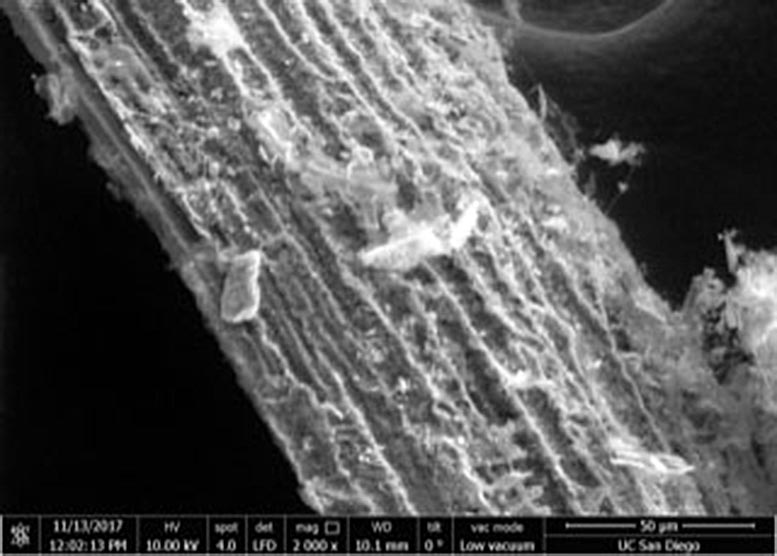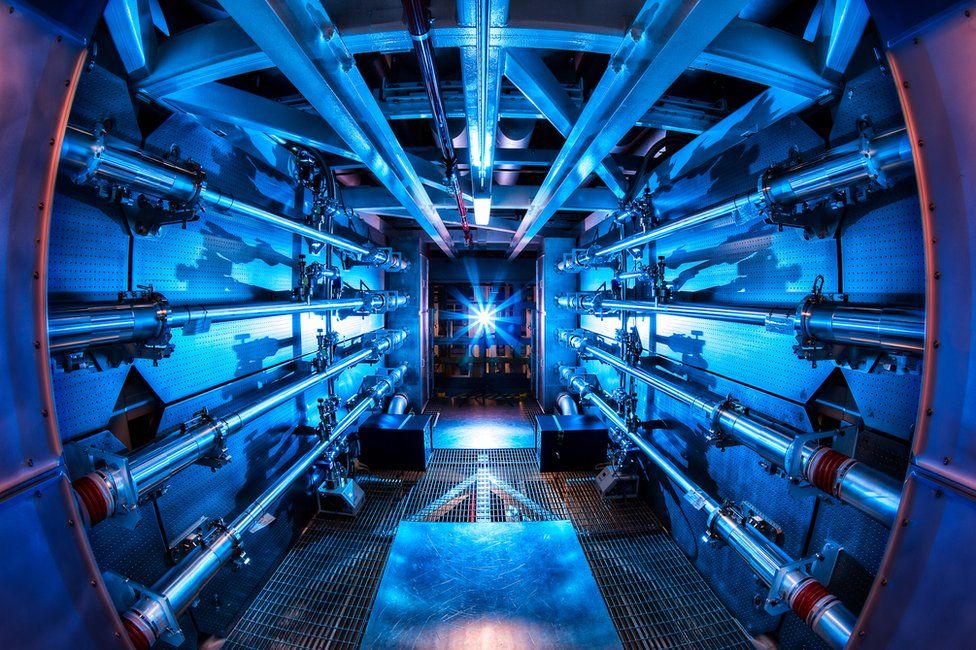
Lawrence Livermore National Laboratory (LLNL) announced today that it has produced a fusion reaction in the laboratory that yielded more energy than was absorbed by the fuel to initiate it.
Zapping a BB-size capsule of fusion fuel with UV light from 192 lasers at the lab’s $3.5 billion National Ignition Facility (NIF), scientists say they sparked fusion reactions that released 1.3 megajoules of energy, about five times the 250 kilojoules that were absorbed by the capsule. That energy emission from the tiny blob of plasma—roughly a cube with sides measuring the width of a human hair—occurred within about 100 trillionths of a second to yield more than 1016 watts of power.
The shot, which occurred on 8 August, demolished the facility’s previous record yield of 170 kJ, observed in February, and was 25 times as high as the best results obtained just a year ago. “Everyone has a spring in their step,” says NIF director Mark Herrmann. The results have not yet been peer reviewed.
Although the achievement represents a milestone in fusion research, the laboratory stopped short of declaring ignition, the goal for which NIF was named and which it had planned to achieve by 2012. The fusion yield fell short of the 1.9 MJ that the NIF laser brought to bear on the hollow target, called a hohlraum, in which the fuel capsule was suspended. A 1997 National Academy of Sciences review of NIF’s design defined ignition as fusion yield equal to or more than the laser energy input. In NIF’s approach, known as indirect drive, 85% of the laser’s energy is lost in the conversion of UV to x rays that occurs inside the hohlraum.
Stephen Bodner, a former director of the laser fusion program at the Naval Research Laboratory (NRL) and a persistent critic of NIF and the indirect drive approach, congratulated the lab on the achievement, saying it was close enough to ignition for him. “They made spectacular progress,” he says. “I’m surprised they found a way to minimize the laser–plasma problems,” he says. He added that “it demonstrates to the world that there’s no fundamental reason why laser fusion can’t work.”
But Bodner cautions that the NIF results won’t extrapolate to higher energy gains due to the inefficiency of the indirect drive process. “If you want to get to high gains, you have to directly illuminate the target,” he says, referring to an approach pursued at the Laboratory for Laser Energetics (LLE) and NRL, where laser beams are symmetrically directed onto the fuel capsule.

Michael Campbell, director of the LLE at the University of Rochester in New York, says that ignition was attained by most scientific measures, including the extent to which alpha particles from fusion reactions heat the plasma and create more fusion. “It gives the US a lab capability to study burning plasmas and high-energy physics relevant for [nuclear weapons] stewardship,” he says. “It’s an enormous scientific achievement.” Like NIF, LLE and its Omega laser are funded by the US Department of Energy’s National Nuclear Security Administration (NNSA).
Jill Hruby is the undersecretary for nuclear security at DOE and the NNSA administrator. “These extraordinary results from NIF advance the science that NNSA depends on to modernize our nuclear weapons and production. It also offers potential new avenues of research into alternative energy sources that could aid economic development and help fight climate change,” she said in a press release.
By most measures, the NIF results exceed the best results achieved in tokamaks, which bottle fusion plasmas in magnetic fields. In 1997 the Joint European Torus generated about 16 MW, roughly two-thirds of the power that it took to start the reaction.
Research on laser fusion, also known as inertial confinement fusion, was initiated at LLNL by John Nuckolls, who went on to become the lab’s director, soon after the invention of the laser in 1960. The goal has always been to create at laboratory scale what happens in the secondary stage of a thermonuclear weapon.
When NIF opened for experiments in 2009, five years behind schedule, LLNL scientists were confident they could reach ignition within two years. That concerted effort, known as the National Ignition Campaign, formally expired in 2012 (see Physics Today, October 2012, page 28), and the frequency of fusion shots was scaled back in favor of other research in support of the nuclear weapons program.
But experimenters continued to test a wide variety of compositions and different shapes of capsules and hohlraums, while also fine-tuning the timing and sequence of the laser pulses. Until now, they’d been unable to implode the fuel capsule with the precise degree of symmetry needed to prevent the plasma from squeezing out.
Over the years, the lab developed a suite of unique diagnostic tools that have provided a clearer picture of the reaction dynamics. Among the tools are 3D neutron and 2D x-ray imaging instruments and neutron time-of-flight detectors (see Physics Today, February 2017, page 33). Herrmann noted that in previous experiments, neutrons exiting the capsule on one side of the implosion arrived a few picoseconds earlier than did those flying off the opposite way. Those exquisitely sensitive measurements indicated that the plasmas were jetting off in one direction. The problem was traced to capsules that were a fraction of a micron out of round.
The lab hasn’t yet reproduced this month’s results, and Herrmann cautioned that doing so might not be straightforward. “We don’t know what variability will be in successive shots. It’s a nonlinear process where alpha heating heats up the fusion fuel and creates more fusion, which creates more heat.” Herrmann says the 3.5 MeV alpha particles, which remain in the plasma, produced 20% of the fusion yield, with 14 MeV neutrons accounting for most of the energy.
Further experiments will require the manufacture of additional fuel capsules and hohlraums. These may not be ready until at least October, Herrmann says. The nanocrystalline diamond-coated capsule that was imploded in this month’s event took six months to grow at General Atomics, which has long worked with LLNL on fabricating capsules. The spheres have to be polished and the core’s interior etched with tools inserted through a 2-micron-diameter hole drilled into it. The tritium–deuterium mixture is injected through a tiny fill tube just prior to the shot.
The lab is still analyzing the results from the shot. It’s not yet known which or what combination of advances to the targets, laser pulse lengths, or other variables led to the leap in performance. Some of the instruments were saturated by the unexpected yield of the reaction. A few that are used in the target chamber for other, non-ignition experiments will need repair.
Herrmann acknowledged that the announcement deviates from the standard practice of peer-reviewed publication. But the results, he says, were leaking, “so we wanted to put it out so people could discuss the facts.”
Editor’s note, 17 August: The first sentence was updated to clarify that the fusion reaction did not meet the National Academy’s definition of ignition.




















